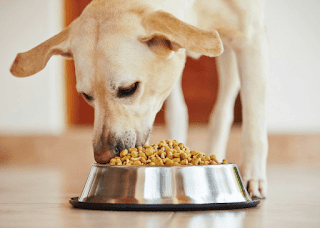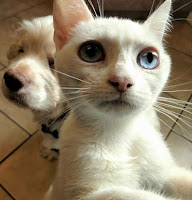The grain free diet was not created by veterinary nutritionists, but by pet food manufacturers.
Following the deaths of animals across the country in 2007, the contaminant causing these deaths was found to be in wheat gluten.
Grains are seeds of grasses cultivated for food. The outer layer of the grain, or bran, provides fiber, while the inner portion, or endosperm, is a good source of starch. The reproductive part of the seed known as the germ, is a good source of vitamin E, folic acid, magnesium, and phosphorus and whole grain is the entire seed. Wheat gluten, is food made from the main protein in wheat.
Consumers needed assurance that their pet food was safe. Pet food companies rushed provide this assurance, and their answer was to limit all grains and market a grain free diet.
According to four diplomats of the college of Veterinary Nutrition, "Vilification of food grains as pet food ingredients may be myths started by small pet food companies as a way to compete with larger, established companies."
Dr. Cailen Heinze, MS, VMD, who is also a member of the American College of Veterinary Nutrition, stated "[The grain free diet] is not based on any data, and there are excellent diets that contain one or more of those items." There are many more veterinary nutritionists that agree that there simply is no science behind the claims made by grain-free pet manufactures.
When grains are removed from from pet food, they have to be replaced by something. Most common are highly refined starches such as tapioca (cassava), potatoes, or sweet potatoes. According to Cummings Veterinary Medical Center at Tufts University "These ingredients often provide fewer nutrients and less fiber than whole grains, while costing more."
We as consumers have been led to believe two (or more) myths by grain free pet food producers. The first myth is that their diets are more healthy for animals with food allergies. While food intolerance may be triggered by some grains actual food allergies are caused by protein, not grains. Beef is the most common culprit in food allergies.
The second myth is that more expensive, grain free diets, are made from human grade meats. Dr. Marion Nestle, the Paulette Goddard professor of food studies and public health at the New York University stated, "All pet foods are made from the byproducts of human food production. No matter what the package says, your dog is not getting whole chicken breasts, but what remains after the breasts have been removed for human food."
One high priced food manufacturer, Blue Buffalo, found they were in trouble on May 6, 2014. Purina, one of the largest pet food companies in America, filed a lawsuit against Blue Buffalo for false advertising after finding the presence of poultry by product meal in some of Blue Buffalo's top selling foods.
Blue Buffalo offered a "True Blue Promise" that states that their food "contain(s) NO chicken (or poultry byproducts, NO corn, wheat or soy, and NO artificial flavors, colors or preservatives." Unfortunately for Blue Buffalo, it did.
After a year of denial, Blue Buffalo admitted that "substantial" and "material" portion or Blue Buffalo pet food sold to consumers contained poultry byproduct.
Dr, Nestle pointed out that "People are willing to spend anything on their pets. The $18-billion-a-year pet food industry is considered to be recession-proof. Although during this economic downturn shelters have been overwhelmed with pets people could not afford to keep, those who have kept their pets are not stinting on what they spend to feed them."
Blue Buffalo sells for $1.26-2.59 per pound while Purina Dog Chow sells for an average of 62¢ per pound.
This begs the question, are pet parents who cannot afford expensive grain-free diets shamed by purchasing cheaper brands? According to Dr. Nestle, while "premium" brand foods cost three to four times more than supermarket brands, no valid research provides evidence of the added value to health and longevity.
While we all want to provide what is best for our pet, we should never be conned into believing a myth. The grain-free diet is one of the biggest myths in the pet food industry.
To learn about the evolutionary basis of pet food nutrition, the safety of our food, actual pet food requirements, and a discussion on BARF or raw diets, please refer to Secrets of a Vet Tech II: A Low Cost Guide to Pet Care Guide for Pet Parents, Animal Shelters, Rescues, & Homesteaders








